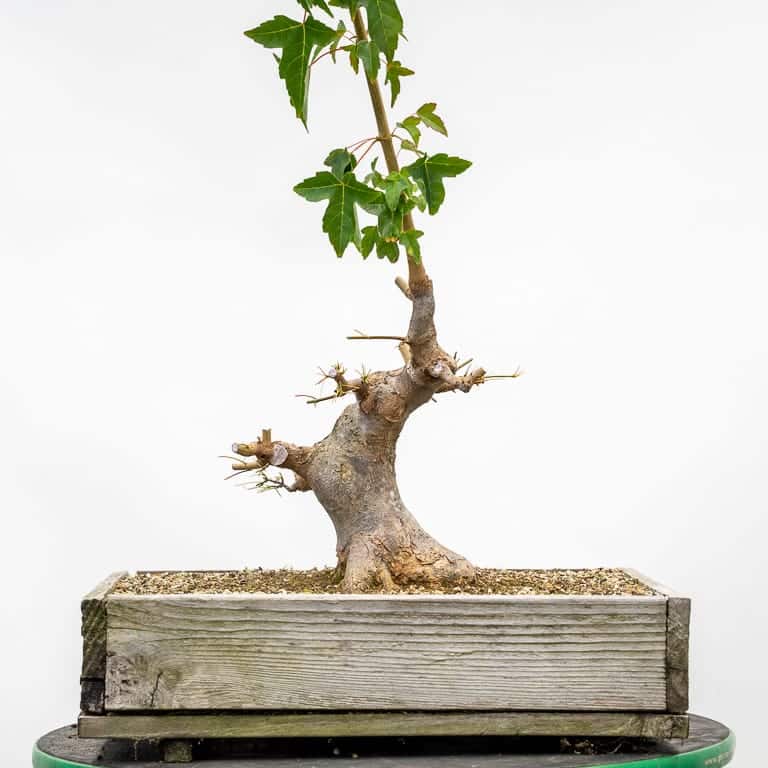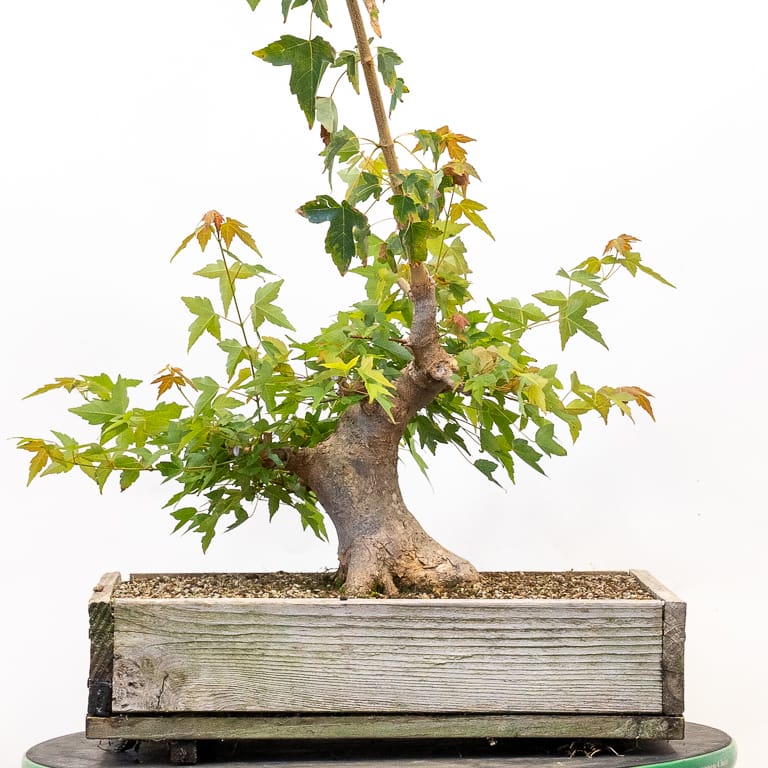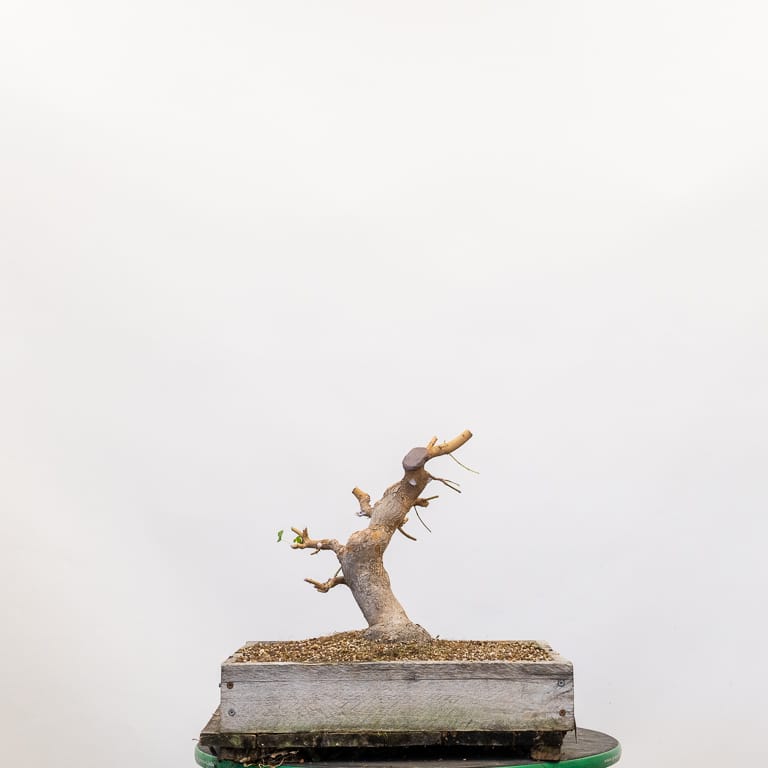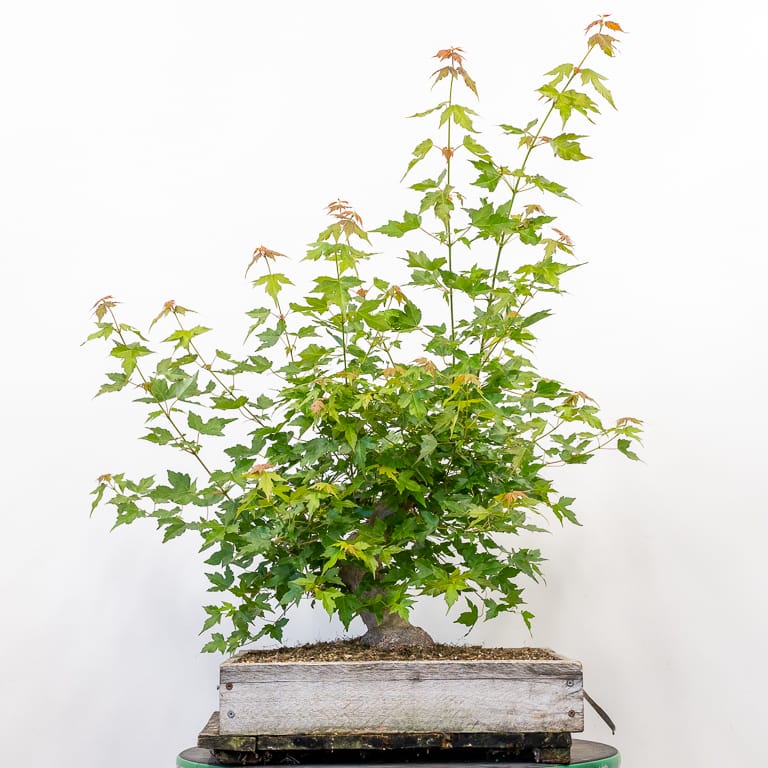Earlier this summer, I pruned and defoliated two field grown trident maples. I reduced all of the branches on one of the trees, and left a sacrifice branch on the other.
Both trees have grown vigorously since they were pruned, but they produced growth in different areas.
The tree with the sacrifice branch produced a small amount of low growth, but invested most of its resources to extend the sacrifice branch which is now over eight feet long.

Trident maple after cutback and defoliation – July, 2020

New shoots on the lower branches eight weeks later
I reduced all of the branches on the second tree, and as a result, it produced more vigorous growth along the trunk.

After cutback and defoliation in July

New shoots on the trunk eight weeks later
Knowing how trees respond in these two cases helps us determine whether or not we’re better off keeping or removing sacrifice branches.
If the goal is to thicken or extend the trunk, heal large wounds, or strengthen the roots, I’ll leaving sacrifice branches alone. If the goal is to encourage as much new growth as possible on the branches that will form the future silhouette, I’ll reduce sacrifice branches.
In the case of the trident maples above, I’ll let the trees grow freely until the leaves start to turn color at which point I’ll prune and wire the branches in preparation for next year’s growth.
New Resource: How to grow bonsai from seed or cutting
For those interested in growing bonsai from scratch, I’ve created an easy-to-follow overview of the process to help get you started.
The guide, “How to grow bonsai from seed or cutting,” identifies development goals for each stage of development to help you avoid common pitfalls.
I wrote the guide for people who are interested in investing the time and energy required to create quality bonsai. You can read the guide now at the link below:
How to grow bonsai from seed or cutting
Subscribe to Bonsai Tonight
New Posts Delivered Every Tuesday and Friday
Mark says
1. This is not a surprise. Don’t tell me you’re surprised.
2. If you think that having only two items (one per each method) in an experiment and concluding something out of it, it’s unreliable at least.
M.
Bart says
Nevertheless, we are all very grateful for what Jonas is doing! Maybe it doesn’t go by the book rules – but that knowledge is priceless. Keep up the good work J.! I am really inspired by Your sincere dedication!
Jonas Dupuich says
Will do – thanks, Bart!
Jonas Dupuich says
Thanks, Mark! You’re exactly right, there’s no surprise, and no hard science here – when we prune, we can expect a response. The idea is to show the result of making decisions relating to sacrifice branches and to provide guidance for when to remove them.
MBA says
Thank you for sharing.
What soil and fertilizer do you use for maple trees in development. The ones recommended in Peter Adam’s book on Japanese maples seems outdated.
Thank you
MBA
Jonas Dupuich says
This year I mostly used fish emulsion with some Dyna-Gro Foliage Pro on all of the trees in my garden. I use a mix of fertilizers from year to year and mostly use the same products on young trees as I do on old trees. That said, I do far more fertilizer tests on young trees than I do on old trees.
In general, I’d recommend organic fertilizers for all bonsai, especially for refined or mature trees. I think most fertilizers, if applied properly, can work for younger trees in development.
MBA says
Thank you for your reply. And what soil do you use for maple trees in development?
On another note, I enjoyed reading your book!
Best wishes,
MBA
Curt says
So Jonas I am using the colander method to grow on or thicken trunk on mostly deciduous and Azaleas to be Shohin trees. My question is I have left one sacrifice branch grow out to thicken the trunk. Do I cut the sacrifice branch each year in the fall/winter and grow another next year?
Jonas Dupuich says
Hi Curt – the short answer is that you cut when the branch has provided the thickening you want it to provide. Sacrifice branches typically grow for 2-3 years up to 5-8 years depending on the development goals and the rate of growth. If you have specific questions about your trees, feel free to post them with photos to the forum: https://ask.bonsaitonight.com/
Marty Weiser says
I was curious about how long you typically grow out the initial trunk on your trident maples before you cut back to start the new leader in a different direction. Do you do it when they are fairly small (1 cm or so) or do you wait until they are more like 2.5 cm knowing that there will be lots of growth above to heal that relatively large wound.
Jonas Dupuich says
Good question – I have yet to figure out the optimal size at which to make a low cut. I’m trying the technique of building the trunk by making multiple cuts, year after year, that each trigger new shoots (that lead to more cuts, etc.). The alternative is to let the trunk thicken for several years and then cutting when it’s time to start focusing on the next section of trunk (i.e. a section that goes in another direction or will be more slender to create taper). I’m more familiar with the latter approach so am now curious to learn how the former might work. I’ll post updates as I have them.
Amin says
Jonas, do you think that the tree with sacrifice branch removed will have internodes that are too long?
Jonas Dupuich says
Great question Amin – the internodes on most of these branches will be too long to use, but I don’t plan to use these branches anyway. When the growth is dense like this, there are often smaller branches in the interior that will make better candidates for branches that I can use in the final design. I’ll be selecting and wiring these branches later this fall.